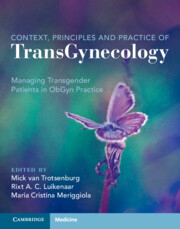Book contents
- Context, Principles, and Practice of Transgynecology
- Context, Principles, and Practice of Transgynecology
- Copyright page
- Dedication
- Contents
- Foreword
- Preface
- Contributors
- Abbreviations
- Section A Contextual Transgynecology
- Section B Practicing Transgynecology
- Section C Gynecological Surgery for Transgender Males
- Chapter 18 Gender-affirming Hysterectomy for Trans Men
- Chapter 19 Opportunistic Salpingectomy in Transgender and Gender Diverse People
- Chapter 20 Colpectomy
- Section D Sexuality and Contraception
- Section E Fertility and Reproduction
- Section F Impact of Gender-affirming Hormonal Therapy on Genital Organs
- Section G Screening and Prophylaxis
- Transgynecology Index
- References
Chapter 20 - Colpectomy
from Section C - Gynecological Surgery for Transgender Males
Published online by Cambridge University Press: 22 December 2022
- Context, Principles, and Practice of Transgynecology
- Context, Principles, and Practice of Transgynecology
- Copyright page
- Dedication
- Contents
- Foreword
- Preface
- Contributors
- Abbreviations
- Section A Contextual Transgynecology
- Section B Practicing Transgynecology
- Section C Gynecological Surgery for Transgender Males
- Chapter 18 Gender-affirming Hysterectomy for Trans Men
- Chapter 19 Opportunistic Salpingectomy in Transgender and Gender Diverse People
- Chapter 20 Colpectomy
- Section D Sexuality and Contraception
- Section E Fertility and Reproduction
- Section F Impact of Gender-affirming Hormonal Therapy on Genital Organs
- Section G Screening and Prophylaxis
- Transgynecology Index
- References
Summary
Colpectomy and vaginectomy are synonymous. Some patients may prefer the term colpectomy because the term “vagina” may be tainted. Parallel to the growing numbers of transmen transitioning, an increasing demand for colpectomy is observed. The reasons to undergo colpectomy vary from disgust for vaginal discharge, pain due to senile colpitis, dysphoria due to the presence of the vagina, and most importantly a clear reduction of complications during surgical urethra lengthening procedures, or combination thereof. Surgery may be performed at the same time as hysterectomy or may be staged and can be done through a fulguration technique or excisional technique. Access to the vaginal lining can be obtained either vaginally or laparoscopically. Colpectomy to date is still a procedure rarely performed and should be carried out by experienced professionals as complications are rare but potentially severe. Also, vaginal remnants due to incomplete removal of the vaginal lining are a particularly challenging complication. These can occur in isolation or may communicate with the urethra as a fistula or diverticulum.
- Type
- Chapter
- Information
- Context, Principles and Practice of TransGynecologyManaging Transgender Patients in ObGyn Practice, pp. 148 - 157Publisher: Cambridge University PressPrint publication year: 2022
References
- 1
- Cited by



